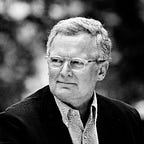Creative Commons of Innovation
Amanda Schaffer writes in the MIT Technology Review about “Tech’s Enduring Great Man Myth” She describes the myth:
“The problem with such portrayals is not merely that they are inaccurate and unfair to the many contributors to new technologies. By warping the popular understanding of how technologies develop, great-man myths threaten to undermine the structure that is actually necessary for future innovations.”
Then what would be an alternative view to innovation?
Charles Darwin is reported to have written 15.000 letters during his career. The case becomes interesting if we assume that he received roughly the same number of letters as he sent. Think about the time he spent reading and writing; think about the time he spent networking. Would we have advised Charles to limit his time spent on social media and stick to his productive work, perhaps not.
The history lessons taught in schools and leadership case studies taught in management education classes see the properties and ideas of particular persons as the drivers of the events that unfold in the world. Even today, this reinforces the common notion that history is made by outstanding individuals. But is it really so that if Newton had never been born, we would still be ignorant about gravitation? Or do we think that without Steve Jobs, there would have been no smartphone revolution or without Elon Musk, no surge of interest in electric vehicles, as Amanda Schaffer asks.
Does the great man theory of innovation, science and business really help us to understand the world we live in? We always try to make sense of our experiences and explain both to ourselves and to others what is going on, the way we understand what is going. Often the sense making we use is based on outdated mental models or yesterday’s science and often it is plain wrong.
Alfred Wallace, the British explorer and anthropologist published his version of the theory of natural selection at the same time as Darwin, or, as many claim, before him. Wallace had an impact on Darwin and among other things, prompted him to publish his work.
The interesting thing here is that a great idea matured in different places roughly at the same time.
However, the idea had a history. Both Wallace and Darwin based their studies on earlier work by the Augustinian priest and scientist Gregor Mendel. To be really fair, we should of course continue the chain and know who the nodes in the network were before Mendel? So instead of talking about Darwinian evolution, we should really call it Darwinian-Wallacian-Mendelian-and-the-scientists-before-them, evolution!
Before the time of universities, scholars depended largely on correspondence networks for the exchange of ideas. These communities, known as the “Republic of Letters” were the social media of the era, following astonishingly closely the communication patterns of today.
Many researchers claim that one of the key success factors in science is the network of the scientist. This was also the case with Darwin. Historians say that Darwin’s network was the decisive thing that tilted the focus towards him and not towards Wallace.
The better-networked scientist is the better scientist. The better-networked knowledge worker is the better knowledge worker. The main difference from the time of Charles Darwin is the efficiency of our tools for networking, our tools for thinking. This is what Darwin used letters for, to think together with his network of contacts. Over 6000 of those letters can be studied at the Darwin Correspondence Project web pages. What is similar to the social media of today is the many casual letters Darwin sent, reflecting his own life and the life around him, sometimes in a very intimate way.
A “man of letters” may today be a man of tweets, posts and Facebook updates, but the principle is the same: the size and quality of the network matters. What matters even more than the network, is networking, the way we use the network. In trying to understand what is going on, we should shift our focus from independent events and independent heroic people to networked temporality, the common movement of thought. Amanda Schaffer writes:
“Scholars are eager to identify and give due credit to significant people but also recognize that they are operating in a context which enables the work. In other words, great leaders rely on the resources and opportunities available to them. They do not shape history as much as they are molded by the moments in which they live, although corporate leaders often insist on a success story that fails to acknowledge the importance of support from the government”
Even more than understanding networking, we should acknowledge the inherently creative commons nature of thinking, innovation and all development. It all takes place in interaction.
.
